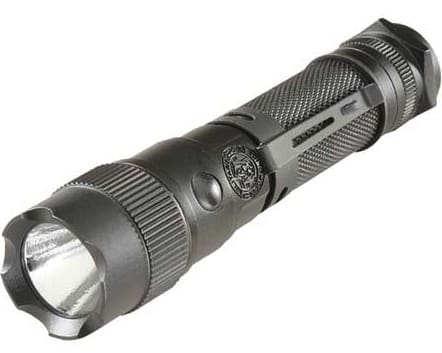The human species is light-dependent. Most businesses operate during daylight hours. We have a “day job.” So what happens when the light goes away in a situation where you need a defensive firearm to protect your life and your loved ones? Unless you have shiny deer-eyes (thanks to illegal prison surgery) you’re gonna need a flashlight—and know how to use it. Last night, CrimsonTrace showed me the light . . .
Scenario one: no illumination. Don’t let the video’s mid-day brightness confuse you; it was nearly pitch black outside as we ran this drill. We could see silhouettes of our targets, knew they were hostile, and knew they had to be engaged. The results were not so spectacular. Yes, it’s a video of darkness and muzzle-flash. Point taken?
Scenario two: testing various light-bearing firing positions from SureFire’s “cigar” hold to the FBI “I’m going to wave this above my head like a lunatic and draw your attention away from my center of mass while I engage you at 15 yards with one hand” style of hold.
Though I had been running a Lightguard-equipped gun all day in the off position, I unfortunately didn’t get my hands on the Lightguard for this run (nor was my pistol equipped with Lasergrips). So I was using a Smith and Wesson Tactical Strobe 120lumen LED patrol light [above].
Notice a difference? So did the bad guy. Having the ability to identify, disorient (read: blind) and positively engage your target isn’t something to be taken lightly. So to speak. If you carry a firearm, carry a light.





I’ve long advocated a tactical light as an essential part of my daily gear. In fact, I find myself using my tactical light more often than even my tactical knife. My preference is the Leupold tactical, as it combines a low beam/high beam/strobe in a modular, LED package that can be configured for either one or two batteries. My biggest problem is trying to shoot two-handed with a light, since none of my handguns are equipped with rails. Which is why I practice shooting one-handed so often.
Any tips for how to grip the light and the gun in a two-handed grip and still make the light useful?
That’s the “cigar grip” he was referring to. Hold your torch between the index and middle fingers of your support hand, and use your thumb to turn it on and off. Your middle, ring, and pinky fingers are able to provide a little–not much–added support to your pistol.
I found this link on another blog (Caleb @ gunnuts.net). http://www.nrapublications.org/si/hb_handgun.html
(note: you will need to open the window to fullscreen as the article is on the far right side)
I will be trying these different grips with snapcaps here at home, since as Chris Dumm noted, it is difficult to find a range that will allow this type of practice.
A bright and sturdy light is the one element of our daily carry kits that is likely to be used frequently and in a wide variety of situations. Most of us (thank God) will never have to shoot, stab or pepper-spray an assailant, but we’ll all occasionally need to see something in the dark.
I’m sadly out of practice in night-firing with a light. It’s considered automatically reckless to do so in my public shooting quarries, and my local ranges prohibit it as well.
My flashlight goes wherever I go. I’ve found it as useful as my Swiss Army Knife. Essential.
We shoot 3 night matches every year at our local club. Lovingly referred to as “Murphy Matches”. If it can, it will go wrong at these matches. You really learn what part of your kit works. Also, multi mode flashlights tend to go to the low mode or strobe mode when you don’t expect it. Recoil can cause you to bump the switch. I no longer carry a multi mode light as my primary for that reason.
Love the Pitch Black reference!
Comments are closed.